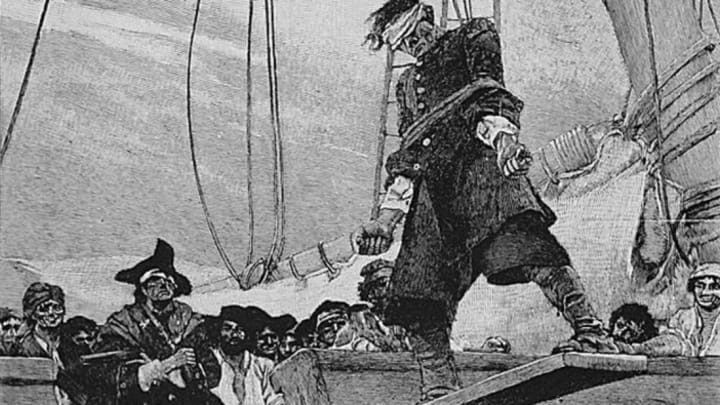Happy Talk Like a Pirate Day, mateys! Abstain from this nautical celebration and you’ll likely be told to “Go walk the plank” by some eye patch-wearing devotees.
It’s a form of punishment storytellers have been waxing about for centuries. Treasure Island , Robert Louis Stevenson’s adventuresome magnum opus, mentions plank-walking on several occasions. Movie-makers publicized the practice still further, as demonstrated by this catchy number from Disney’s Peter Pan:
Thanks to all that media attention, many now believe walking the plank was downright commonplace on real-life pirate vessels. However, historical records paint a more ambiguous picture.
Among the first non-fiction, English-language books to cover buccaneers and their lifestyle was A General History of the Pyrates. Originally published in 1724 by an author working under the pseudonym “Captain Charles Johnson,” it claims that—back in ancient Roman times—Mediterranean pirates would facetiously offer prisoners their freedom via holding ladders over the open ocean and inviting them to swim back home.
Yet, most primary accounts of walking the plank are sketchy at best. Before his execution in 1769, a seaman named George Wood confessed that he’d forced at least one prisoner to do so. But, alas, Wood was no pirate but rather a common mutineer.
Fifty-three years later, an eyewitness would write that British ship captain William Smith was taken by some bona fide gentlemen of fortune. After nabbing him, the survivor recalls, “a plank was run on the starboard side of [their] schooner, upon which [they] made Captain Smith walk, and… as he approached to the end, they tilted the plank, when he dropped into the sea”.
Most historians conclude that, while plank-walking did exist, it was relatively rare. For starters, many captives would’ve been kept alive and held hostage, as was the case for a young Julius Caesar in 75 BCE. And when buccaneers really did mean to off somebody, plenty of other options were available, such as marooning, which nearly always resulted in death.
If a more sadistic measure was desired, “keelhauling” fit the bill perfectly. This involved stripping the victim, tying him to a rope, throwing him overboard, and dragging him beneath the length of the ship as razor-sharp barnacles sliced through his skin. Yikes!
